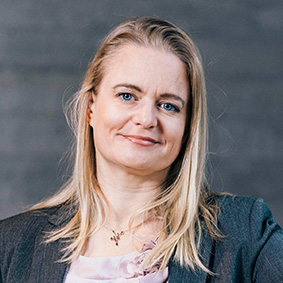From picoseconds to decades: modelling materials for future energy

Professor Andrea Sand is joining Aalto University’s department of Applied Physics. Professor Sand uses computer simulations to study how materials behave, which is useful when the materials are subject to conditions that are hard to examine in traditional ways, like being inside the walls of a nuclear reactor, or in outer space. We spoke to her about her work:
What do you study and why?
I research how radiation affects materials using computer simulations. We do this because the processes that cause radiation damage are so fast and happen on such a small scale that it is very difficult to observe them with regular experiments, so simulations are the only way to examine them. What’s more, the situations where radiation damage is happening are too extreme to recreate safely in a laboratory, like the radiation levels in a nuclear reactor, or cosmic radiation in space. So to understand the processes and predict the possible effects, we have to model them using computers instead.
My main focus is on future applications of materials where radiation will be a key part, which includes nuclear fusion, and the next generation of nuclear fission. In existing fission reactors, the materials have been in place for decades so we can take them apart and look how they’ve changed, but for next generation reactor designs we can’t do that yet, so simulations are important in designing them.
The reason it’s important to study radiation damage is because over time, radiation changes how materials behave. For example, the thermal conductivity of a material changes over time when it is exposed to radiation. Thermal conductivity is an important property of a reactor because we need to get the heat out of the reactor to turn it into useful electrical energy. An even more important property of a reactor from a safety point of view is structural integrity. Radiation can make materials become more brittle at different temperatures than usual, so it is important to predict this so reactors can be designed safely.
A topic that I have begun to study more recently is how radiation affects semiconductors. This is relevant for improving the radiation damage-resistance of electronics on spacecraft, but also for increasing the resolution of low-temperature particle detectors, such as the ground-based semiconductor detectors used in the search for dark matter.
What interests you about the field?
The radiation responses of materials is a big constraint on future energy technologies. So the questions are important and challenging. If we manage to tackle the safety and commercial feasibility, nuclear energy from fission and fusion will be able to both meet the growing energy demand and combat climate change at the same time.
On a fundamental level I personally enjoy rigorous mathematical models, but I appreciate the ability of simulations to sit at the interface between analytical models and real world experiment. My background is in pure theoretical physics, my very first paper was on the logical foundations of quantum mechanics, to model its limits and approximations. Since then I have moved into models with more real life data and assumptions, but with more real life applications too.
What do you expect from the future
We need to be able to understand the material changes that take place at all scales, from picoseconds to decades, to be able to guarantee the structural integrity of nuclear devices throughout their whole lifetime.
Nuclear energy suffers from serious stigma because of historical missteps and a fear of the unknown. In my role as a professor at Aalto I would like to help mitigate some of the fears concerning radiation, we often forget that we are continuously subjected to small amounts of radiation, from sources that naturally occur in our surroundings. I think though that we’re on the threshold of change, primarily because of the issues of climate change, so the feeling towards it will change as society recognises nuclear energy as a clean and practically infinitely abundant energy source.
Contact information:

Read more news

Herd immunity may not work how we think
A new study from researchers at Aalto University suggests that our picture of herd immunity may be incomplete — and that understanding how people are connected could be just as important as knowing how many are immune.
Aalto computer scientists in ICML 2025
Department of Computer Science papers accepted to International Conference on Machine Learning (ICML)
New quantum record: Transmon qubit coherence reaches millisecond threshold
The result foreshadows a leap in computational capabilities, with researchers now inviting experts around the globe to reproduce the groundbreaking measurement.






